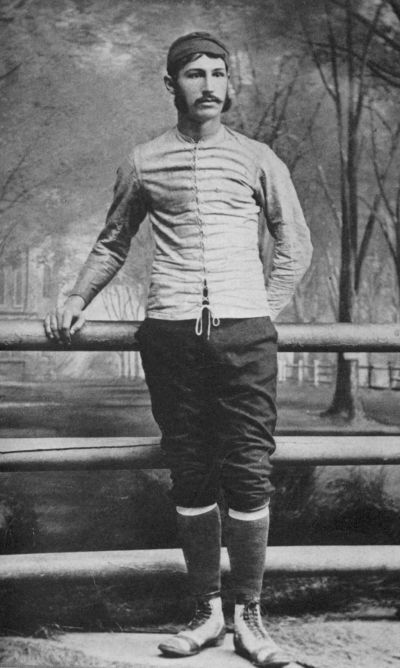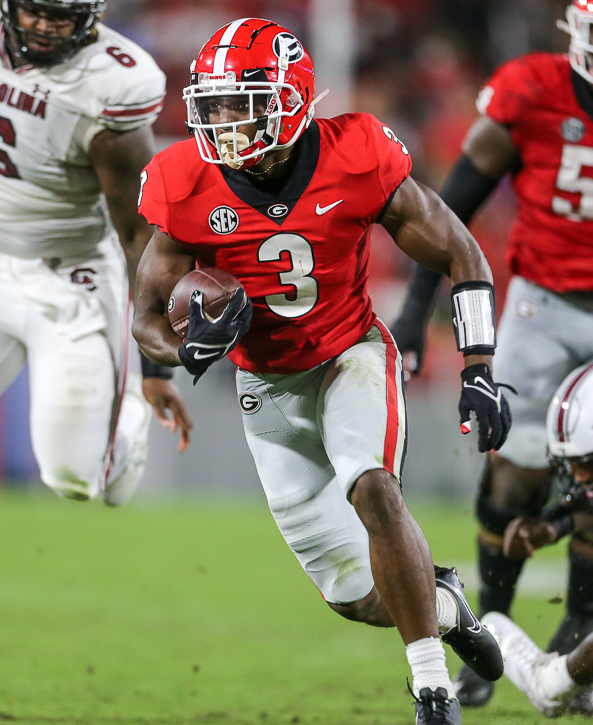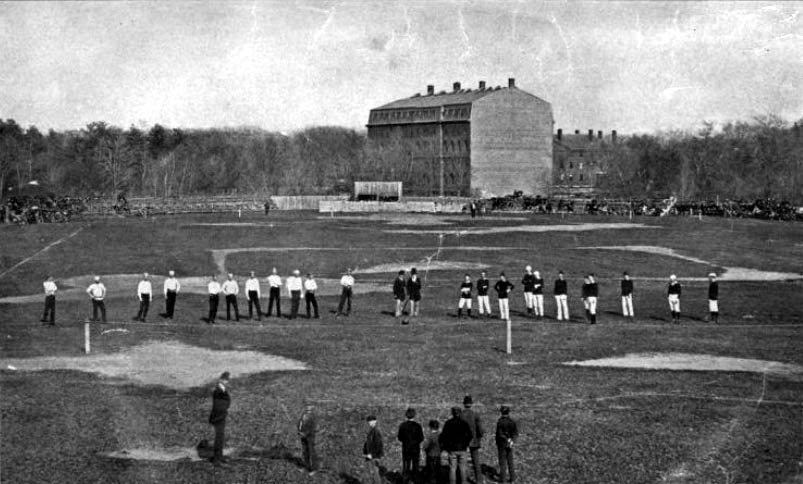|
Backfield
The offensive backfield is the area of an American football field behind the line of scrimmage. The offensive backfield can also refer to members of offense who begin plays behind the line, typically including any backs on the field, such as the quarterback, halfbacks and fullback. History The modernization of the roles of lineman and backs is often traced to Amos Alonzo Stagg. Some of the greatest backfields in the history of college football include those of the 1912 Carlisle Indians, 1917 Georgia Tech Golden Tornado, 1924 Notre Dame Fighting Irish, and 1945 Army Cadets. Joe Guyon was a member of both the aforementioned Carlisle and Georgia Tech teams. Typically, quarterbacks or halfbacks passed the ball, and fullbacks handled kicking duties. Play in the backfield Most running plays begin with a hand-off in the offensive backfield. All kicks and punts must take place in the offensive backfield. If the offensive ball-carrier is tackled in the backfield, the team wil ... [...More Info...] [...Related Items...] OR: [Wikipedia] [Google] [Baidu] |
Joe Guyon
Joseph Napoleon "Big Chief" Guyon (Anishinaabe: ''O-Gee-Chidah'', translated as "Big Brave"; November 26, 1892 – November 27, 1971) was an American Indian from the Ojibwa tribe (Chippewa) who was an American football and baseball player and coach. He played college football at the Carlisle Indian Industrial School from 1912 to 1913 and Georgia Tech from 1917 to 1918 and with a number of professional clubs from 1919 to 1927. He was inducted into the Pro Football Hall of Fame in 1966 and the College Football Hall of Fame in 1971. Early life Guyon was born on the White Earth Indian Reservation in White Earth, Minnesota. He received only a sixth-grade education from the American government. Guyon also spent time in Magdalena, New Mexico. Football career College Carlisle Guyon attended and played college football at the Carlisle Indian Industrial School from 1912 to 1913 under head coach Pop Warner. Sportswriters often tried to call him " Injun Joe" after the character ... [...More Info...] [...Related Items...] OR: [Wikipedia] [Google] [Baidu] |
American Football
American football (referred to simply as football in the United States and Canada), also known as gridiron, is a team sport played by two teams of eleven players on a rectangular field with goalposts at each end. The offense, the team with possession of the oval-shaped football, attempts to advance down the field by running with the ball or passing it, while the defense, the team without possession of the ball, aims to stop the offense's advance and to take control of the ball for themselves. The offense must advance at least ten yards in four downs or plays; if they fail, they turn over the football to the defense, but if they succeed, they are given a new set of four downs to continue the Glossary of American football#drive, drive. Points are scored primarily by advancing the ball into the opposing team's end zone for a touchdown or kicking the ball through the opponent's goalposts for a field goal. The team with the most points at the end of a game wins. American foot ... [...More Info...] [...Related Items...] OR: [Wikipedia] [Google] [Baidu] |
Halfback (American Football)
A halfback (HB) is an offensive position in American football, whose duties involve lining up in the offensive backfield and carrying the ball on most rushing plays, i.e. a running back. When the principal ball carrier lines up deep in the backfield, and especially when that player is placed behind another player (usually a blocking back), as in the I formation, that player is instead referred to as a tailback. Sometimes the halfback can catch the ball from the backfield on short passing plays as they are an eligible receiver. Occasionally, they line up as additional wide receivers. When not running or catching the ball, the primary responsibility of a halfback is to aid the offensive linemen in blocking, either to protect the quarterback or another player carrying the football. History Overview Before the emergence of the T formation in the 1940s, all members of the offensive backfield were legitimate threats to run or pass the ball. Most teams used four offensiv ... [...More Info...] [...Related Items...] OR: [Wikipedia] [Google] [Baidu] |
Running Back
A running back (RB) is a member of the offensive backfield in gridiron football. The primary roles of a running back are to receive handoffs from the quarterback to rush the ball, to line up as a receiver to catch the ball, and block. There are usually one or two running backs on the field for a given play, depending on the offensive formation. A running back may be a halfback (in certain contexts also referred to as a "tailback" — see below), a wingback or a fullback. A running back will sometimes be called a "feature back" if he is the team's starting running back. Halfback/tailback The halfback (HB) or tailback (TB) position is responsible for carrying the ball on the majority of running plays, and may frequently be used as a receiver on short (or sometimes long, depending on the system) passing plays. In the modern game, an effective halfback must have a blend of both quickness and agility as a runner, as well as sure hands and good vision up-f ... [...More Info...] [...Related Items...] OR: [Wikipedia] [Google] [Baidu] |
College Football
College football (french: Football universitaire) refers to gridiron football played by teams of student athletes. It was through college football play that American football rules first gained popularity in the United States. Unlike most other sports in North America, no official minor league farm organizations exist in American or Canadian football. Therefore, college football is generally considered to be the second tier of American and Canadian football; one step ahead of high school competition, and one step below professional competition (the NFL). In some areas of the US, especially the South and the Midwest, college football is more popular than professional football, and for much of the 20th century college football was seen as more prestigious. A player's performance in college football directly impacts his chances of playing professional football. The best collegiate players will typically declare for the professional draft after three to four years of collegia ... [...More Info...] [...Related Items...] OR: [Wikipedia] [Google] [Baidu] |
Four Horsemen (American Football)
The Four Horsemen of Notre Dame comprised a group of American football players at the University of Notre Dame under coach Knute Rockne. They were the backfield of Notre Dame's 1924 football team. The players that made up this group were Harry Stuhldreher, Don Miller, Jim Crowley, and Elmer Layden. In 1924, a nickname coined by sportswriter Grantland Rice and the actions of a student publicity aide transformed the Notre Dame backfield of Stuhldreher, Crowley, Miller, and Layden into one of the most noted groups of collegiate athletes in football history, the Four Horsemen of Notre Dame. Quarterback Harry Stuhldreher, left halfback Jim Crowley, right halfback Don Miller, and fullback Elmer Layden had run rampant through Irish opponents' defenses since coach Knute Rockne devised the lineup in 1922 during their sophomore season. During the three-year tenure of the Four Horsemen, Notre Dame lost only two games; one each in 1922 and 1923, both to Nebraska in Lincoln before packe ... [...More Info...] [...Related Items...] OR: [Wikipedia] [Google] [Baidu] |
American Football Plays
In American football, a play is a close-to-the-ground plan of action or strategy used to move the ball down the field. A play begins at either the snap from the center or at kickoff. Most commonly, plays occur at the snap during a down. These plays range from basic to very intricate. Football players keep a record of these plays in a playbook. Order of a play A play begins in one of two ways: *A play from scrimmage begins when the ball is delivered from the center to a back, usually the quarterback. *A free kick Once the play begins, it will continue until one of the following events happens: *The ball carrier is down, usually defined as when any body part besides the hands and feet touches the ground. *The ball carrier's forward progress is stopped to the point where a stalemate occurs and it is clear that the ball cannot be advanced any farther, nor is he easily going down as defined above. *The ball carrier steps ''out of bounds''. *A forward pass touches the ground before it i ... [...More Info...] [...Related Items...] OR: [Wikipedia] [Google] [Baidu] |
American Football Positions
In American football, the specific role that a player takes on the field is referred to as their "position". Under the modern rules of American football, both teams are allowed 11 players on the field at one time and have "unlimited free substitutions", meaning that they may change any number of players during any "dead ball" situation. This has resulted in the development of three task-specific "platoons" of players within any single team: the offense (the team with possession of the ball, which is trying to score), the defense (the team trying to prevent the other team from scoring, and to take the ball from them), and the so-called 'special teams' (who play in all kicking situations). Within these three separate "platoons", various positions exist depending on the jobs that the players are doing. Offense In American football, the offense is the team that has possession of the ball and is advancing toward the opponent's end zone to score points. The eleven players of the offe ... [...More Info...] [...Related Items...] OR: [Wikipedia] [Google] [Baidu] |
History Of American Football
The history of American football can be traced to early versions of rugby football and association football. Both games have their origin in multiple varieties of football played in the United Kingdom in the mid-19th century, in which a football is kicked at a goal or kicked over a line, which in turn were based on the varieties of English public school football games descending from medieval ball games. American football resulted from several major divergences from association football and rugby football. Most notably the rule changes were instituted by Walter Camp, a Yale University athlete and coach who is considered to be the "Father of American Football". Among these important changes were the introduction of the line of scrimmage, of down-and-distance rules, and of the legalization of forward pass and blocking. In the late 19th and early 20th centuries, gameplay developments by college coaches such as Eddie Cochems, Amos Alonzo Stagg, Parke H. Davis, Knute Rockne, an ... [...More Info...] [...Related Items...] OR: [Wikipedia] [Google] [Baidu] |
Quarterback
The quarterback (commonly abbreviated "QB"), colloquially known as the "signal caller", is a position in gridiron football. Quarterbacks are members of the offensive platoon and mostly line up directly behind the offensive line. In modern American football, the quarterback is usually considered the leader of the offense, and is often responsible for calling the play in the huddle. The quarterback also touches the ball on almost every offensive play, and is almost always the offensive player that throws forward passes. When the QB is tackled behind the line of scrimmage, it is called a sack. Overview In modern American football, the starting quarterback is usually the leader of the offense, and their successes and failures can have a significant impact on the fortunes of their team. Accordingly, the quarterback is among the most glorified, scrutinized, and highest-paid positions in team sports. ''Bleacher Report'' describes the signing of a starting quarterback as a Catch ... [...More Info...] [...Related Items...] OR: [Wikipedia] [Google] [Baidu] |
Fullback (American Football)
A fullback (FB) is a position in the offense (sports), offensive backfield in gridiron football, and is one of the two running back positions along with the halfback (American football), halfback. Fullbacks are typically larger than halfbacks and in most offensive schemes the fullback's duties are split among power running, pass catching, and blocking for both the quarterback and the other running back. Many great runners in the history of American football have been fullbacks, including Jim Brown, Marion Motley, Bronko Nagurski, Jim Taylor (fullback), Jim Taylor, Franco Harris, Larry Csonka, John Riggins, Christian Okoye, and Levi Jackson. However, many of these runners would retroactively be labeled as halfbacks, due to their position as the primary ball carrier; they were primarily listed as fullbacks due to their size and did not often perform the run-blocking duties expected of modern fullbacks. Examples of players who have excelled at the hybrid running–blocking–pass-cat ... [...More Info...] [...Related Items...] OR: [Wikipedia] [Google] [Baidu] |
1945 Army Cadets Football Team
The 1945 Army Cadets football team was an American football powerhouse that represented the United States Military Academy as an independent and considered to be among the greatest in collegiate history. In their fifth season under head coach Earl "Red" Blaik, the Cadets compiled a 9–0 record, shut out five of nine opponents (including a 48–0 victory over No. 2 Notre Dame and a 61–0 victory over No. 6 Penn), and outscored all opponents by a total of 412 to 46. Army's 1945 season was part of a 32-game undefeated streak that included the entire 1944, 1945, and 1946 seasons. In the final AP Poll released on December 2, Army was ranked No. 1 nationally with 1,160 points, more than 200 points ahead of No. 2 Navy. All seven other contemporary major selectors also recognized Army as the 1945 national champion, including the Boand System, Dunkel System, DeVold System, Houlgate System, Litkenhous, Poling System, and Williamson System. Army also garnered six retrospective sel ... [...More Info...] [...Related Items...] OR: [Wikipedia] [Google] [Baidu] |





.png)


